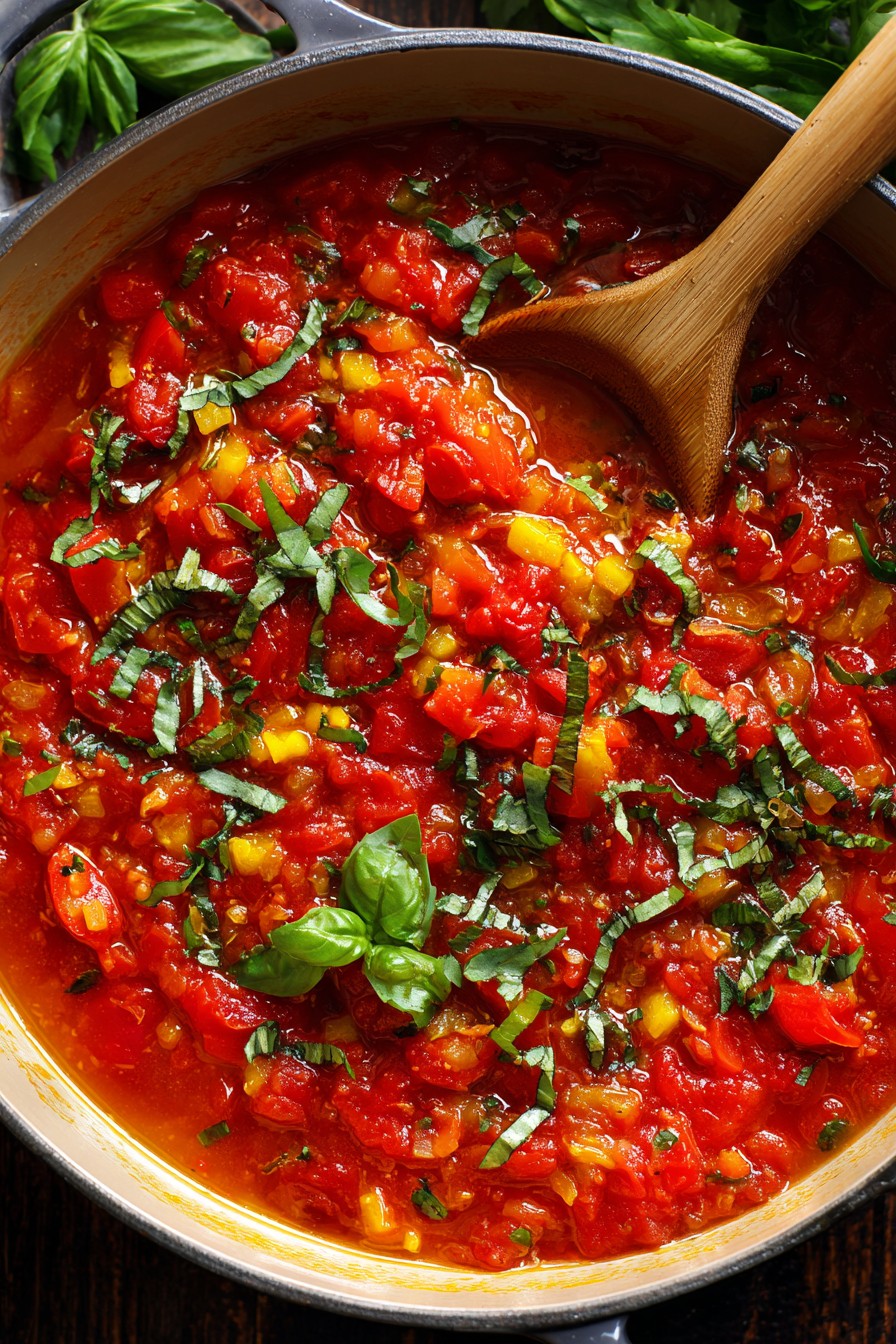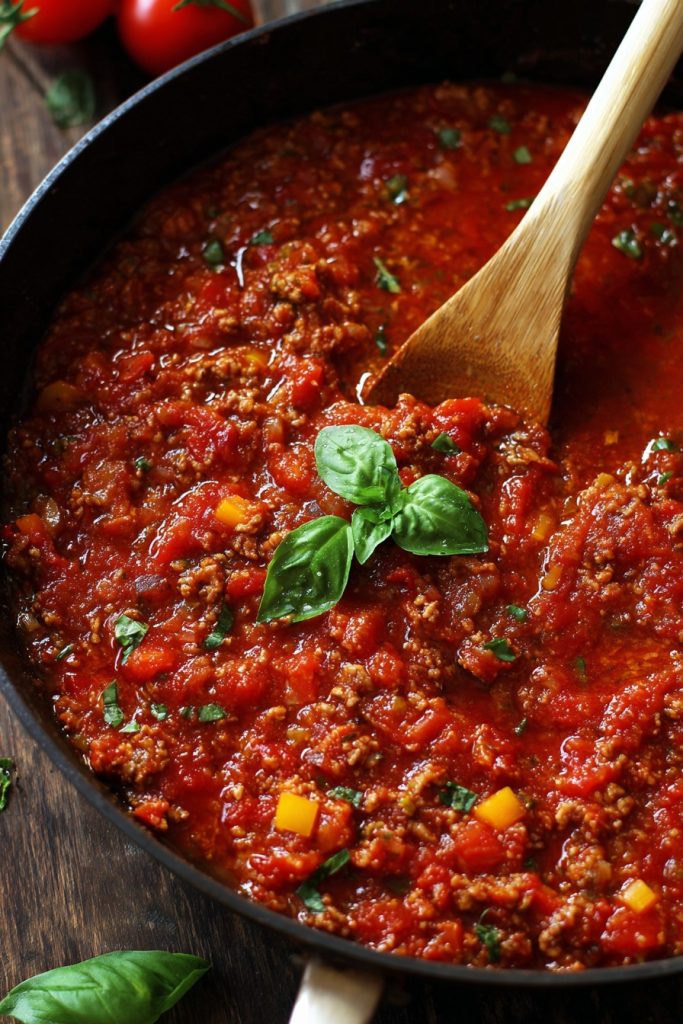Every Sunday afternoon, the scent of simmering tomatoes would drift through our house like a warm embrace, signaling that family was gathering and memories were being made. This wasn’t just tomato sauce—it was the heart of our home, the foundation of countless meals shared around the table with stories, laughter, and the comforting knowledge that we were exactly where we belonged.
Why This Recipe Works
- The slow, gentle simmering allows the tomatoes to break down completely, creating a sauce that’s naturally sweet and velvety smooth without any bitterness, just like my grandmother used to make when she’d spend the entire afternoon tending to the pot while telling us stories about her own childhood kitchen.
- Starting with whole canned tomatoes and crushing them by hand gives you complete control over the texture, creating those beautiful, rustic chunks that hold onto the sauce in the most satisfying way, reminding me of how my mother would let me help crush the tomatoes when I was small, my hands covered in red while she smiled at my enthusiasm.
- The combination of olive oil, garlic, and fresh basil creates layers of flavor that develop and deepen over time, much like family stories that grow richer with each telling, filling your kitchen with an aroma that instantly transports you back to those cherished Sunday afternoons.
- Using both onion and carrot adds natural sweetness that balances the tomatoes’ acidity perfectly, creating a harmonious flavor profile that needs no additional sugar, just as generations of Italian grandmothers have known intuitively, passing down this wisdom through the simple act of cooking together.
Ingredients
- 1/4 cup extra virgin olive oil
- 1 large yellow onion, finely chopped
- 2 medium carrots, peeled and finely diced
- 4 cloves garlic, minced
- 2 (28-ounce) cans whole peeled tomatoes
- 1/2 cup fresh basil leaves, torn
- 1 teaspoon salt
- 1/2 teaspoon black pepper
- 1 teaspoon dried oregano
- 1/2 teaspoon red pepper flakes (optional)
Equipment Needed
- Large heavy-bottomed pot or Dutch oven
- Wooden spoon
- Cutting board and chef’s knife
- Measuring cups and spoons
- Can opener
Instructions

Preparing Your Foundation
Begin by pouring that beautiful golden olive oil into your heaviest pot, the one that feels substantial in your hands like the cast iron skillet my grandmother swore by. Set it over medium heat and wait until the oil shimmers slightly when you tilt the pan, about 2-3 minutes—this is when you’ll add your finely chopped onion and diced carrots. As they hit the hot oil, that wonderful sizzle will fill your kitchen, and you’ll stir them frequently with your wooden spoon, watching as the onions turn translucent and the carrots begin to soften, which should take about 8-10 minutes. You’ll know they’re ready when the onions have lost their raw sharpness and the carrots have brightened in color, releasing their natural sweetness into the air. This foundation is everything—it’s where the magic begins, just as it did in my nonna’s kitchen every Sunday morning when she’d start the sauce before anyone else was awake.
Building the Aromatic Base
Now comes the moment when your kitchen will smell like heaven itself—add your minced garlic to the softened vegetables and stir constantly for exactly 60 seconds, no more and no less. Watch carefully as the garlic becomes fragrant but doesn’t brown, because burned garlic will turn your entire sauce bitter and we want only sweet memories here. The timing is crucial—count it out in your head like my mother taught me, one Mississippi, two Mississippi, all the way to sixty while you keep that wooden spoon moving. You’ll know it’s perfect when the sharp raw garlic scent transforms into something warmer, more complex, and the vegetables glisten with oil and promise. This brief cooking unlocks the garlic’s potential without overwhelming the delicate balance we’re creating, much like how the right words at the right moment can transform an ordinary conversation into a cherished memory.
Transforming the Tomatoes
Here’s where the real magic happens—open those cans of whole tomatoes and pour them into a large bowl, reserving the liquid. Using your clean hands, reach in and crush each tomato gently, feeling them burst between your fingers just like I did as a child standing on a stool next to my grandmother. She’d always say “the hands know what the heart wants” as we worked together, creating a mixture of smooth pulp and satisfying chunks. Tip: Don’t discard the tomato liquid from the cans—this precious nectar holds incredible flavor and will help create the perfect saucy consistency. Add both the crushed tomatoes and their liquid to your pot, along with the salt, pepper, oregano, and optional red pepper flakes if you want a little warmth. Stir everything together with love, watching as the red tomatoes mingle with the golden vegetables, creating that beautiful color I’ve associated with family gatherings my entire life.
The Slow Simmer of Memories
Bring your sauce to a gentle bubble over medium-high heat, then immediately reduce the heat to the lowest possible setting where you’ll see just occasional lazy bubbles breaking the surface. Cover the pot partially, leaving about an inch open for steam to escape—this allows the sauce to reduce and thicken slowly without boiling violently. Now comes the hardest part: patience. Let it simmer for at least 2 hours, stirring every 20-30 minutes to prevent sticking and to watch the transformation unfold. Tip: The longer it simmers, the deeper the flavors become—my grandmother would often let hers go for 4 hours, the entire house filling with that unmistakable scent of love and anticipation. You’ll know it’s ready when the oil rises to the surface in beautiful red pools and the sauce has thickened to coat the back of a spoon perfectly.
Finishing with Freshness
After those long, slow hours of simmering, turn off the heat and stir in your torn basil leaves—this final addition brings a burst of fresh, herbal brightness that lifts the entire sauce. The residual heat will wilt the basil perfectly, releasing its essential oils without turning it bitter or dark. Let the sauce rest for 15 minutes off the heat before serving—this allows the flavors to marry completely and the temperature to become perfect for pasta. Tip: Always add fresh herbs at the end to preserve their vibrant flavor and color, just as my mother taught me when I was finally old enough to be trusted with this important final step. Taste and adjust seasoning if needed, remembering that this sauce should taste like home, like comfort, like all the best memories of your childhood gathered in one spoonful.
Tips and Tricks
If you want to take your sauce to the next level, consider using San Marzano tomatoes—they have fewer seeds, thinner skin, and a sweeter, less acidic flavor that makes them the gold standard for Italian sauces. My grandfather would specially order cases of them from a little Italian market downtown, treating each can like treasure. For an even richer sauce, you can add a parmesan rind during the simmering process—it melts into the sauce, adding incredible umami depth and creaminess without making it cheesy. My aunt always saved her rinds in the freezer specifically for this purpose, and to this day, finding a parmesan rind in my sauce feels like discovering a hidden gift from her. If your sauce tastes too acidic after cooking, don’t reach for sugar—instead, stir in a tablespoon of unsalted butter at the end. The fat molecules bind with the acidic compounds, smoothing out the flavor in a way that feels more natural and sophisticated. I learned this trick from a chef friend who grew up in Rome, and it transformed my sauce-making forever. For those who prefer a completely smooth sauce, you can use an immersion blender after cooking, but I encourage you to try the rustic texture first—those tomato chunks hold the sauce so beautifully on pasta, creating little pockets of intense flavor that remind me of summer gardens. Always make a double batch and freeze portions in airtight containers—this sauce only gets better with time, and having it ready in your freezer means weeknight meals can feel like special occasions. My mother kept frozen sauce for emergencies, but we often requested it even when she had time to make fresh, because somehow that frozen sauce tasted like all the love of every previous batch combined.
Recipe Variations
- For a meaty Sunday gravy, brown 1 pound of Italian sausage or meatballs in the pot before adding your onions and carrots. Remove the meat, then proceed with the recipe, returning the meat to simmer in the sauce during the last hour of cooking. This creates that traditional “Sunday gravy” I remember from childhood—the kind where the meat becomes impossibly tender and the sauce takes on its rich, meaty essence, filling the house with an aroma that promised gathering and celebration.
- Create a creamy vodka sauce by stirring in 1/2 cup of heavy cream and 1/4 cup of vodka during the last 10 minutes of cooking. The alcohol helps release flavor compounds in the tomatoes that are otherwise inaccessible, while the cream adds luxurious richness. This variation always reminds me of special date nights in my twenties, when I wanted to impress with something that felt restaurant-quality but still carried that homemade heart.
- For a puttanesca-inspired twist, add 1/2 cup of chopped kalamata olives, 2 tablespoons of capers, and 4 chopped anchovy fillets with the garlic. The saltiness of these ingredients creates a complex, briny depth that transforms the sauce completely. My adventurous uncle would make this version when he visited, claiming it was how they made it in Naples, and though we teased him, we always cleaned our plates.
- Make a roasted vegetable version by tossing 2 cups of chopped seasonal vegetables (like bell peppers, zucchini, and eggplant) with olive oil and roasting at 400°F for 25 minutes until caramelized, then stirring them into the finished sauce. This reminds me of late summer when gardens overflowed with bounty, and my grandmother would use whatever needed using up, creating unexpected but wonderful combinations that celebrated the season.
Frequently Asked Questions
Can I use fresh tomatoes instead of canned?
Absolutely, though it requires some adjustment. You’ll need about 4 pounds of ripe Roma tomatoes—score an X on the bottom of each, blanch them in boiling water for 60 seconds until the skins loosen, then transfer to ice water. The skins should peel off easily, then you can proceed with crushing them. Fresh tomatoes have more water content, so your sauce may need additional simmering time to reach the proper thickness. I remember helping my grandmother during tomato season when she’d preserve the harvest, the kitchen counters covered with red orbs waiting to become winter comfort.
How long does homemade tomato sauce last in the refrigerator?
Properly stored in an airtight container, your sauce will keep beautifully for 5-7 days in the refrigerator. The flavors actually improve over the first couple of days as they continue to meld together. I often make mine on Saturday for Sunday dinner, then enjoy the leftovers throughout the week—it becomes like a familiar friend that gets better with each meeting. Always cool the sauce completely before refrigerating, and give it a good stir when you reheat it, as some separation is natural.
Can I freeze this sauce for later use?
This sauce freezes exceptionally well for up to 6 months. Portion it into freezer-safe containers or bags, leaving about an inch of headspace for expansion. Thaw overnight in the refrigerator before reheating gently on the stove. My mother always kept several containers in the freezer for busy nights, and pulling one out felt like receiving a gift from her past self—a little piece of Sunday comfort available anytime we needed it most.
Why does my sauce sometimes taste bitter?
Bitterness usually comes from either burned garlic (always cook it briefly over medium heat) or from the tomato seeds and skins. Using high-quality whole peeled tomatoes eliminates the skin issue, while gentle cooking prevents burning. If bitterness persists, the pinch of sugar my grandmother used wasn’t for sweetness but to balance acidity—just 1/2 teaspoon can make all the difference without making the sauce sweet. I’ve found that proper seasoning throughout the cooking process prevents most bitterness issues before they start.
Summary
This tomato sauce represents more than just ingredients—it’s the embodiment of family tradition, slow-cooked memories, and the comforting knowledge that some things, like love and good food, only get better with time. Make it with patience, serve it with joy, and watch as it becomes part of your own family’s story.
Grandma's Sunday Sauce
4
servings15
minutes2
minutesIngredients
Instructions
- 1 Heat olive oil in a large heavy-bottomed pot over medium heat. Add onion and carrot, cooking for 8-10 minutes until softened and fragrant.
- 2 Add minced garlic and cook for 60 seconds, stirring constantly until fragrant but not browned.
- 3 Crush whole tomatoes by hand in a bowl, reserving liquid. Add crushed tomatoes and liquid to pot along with salt, pepper, oregano, and optional red pepper flakes.
- 4 Bring to a gentle bubble, then reduce heat to low and simmer partially covered for 2 hours, stirring every 20-30 minutes until thickened.
- 5 Remove from heat, stir in torn basil leaves, and let rest for 15 minutes before serving.



